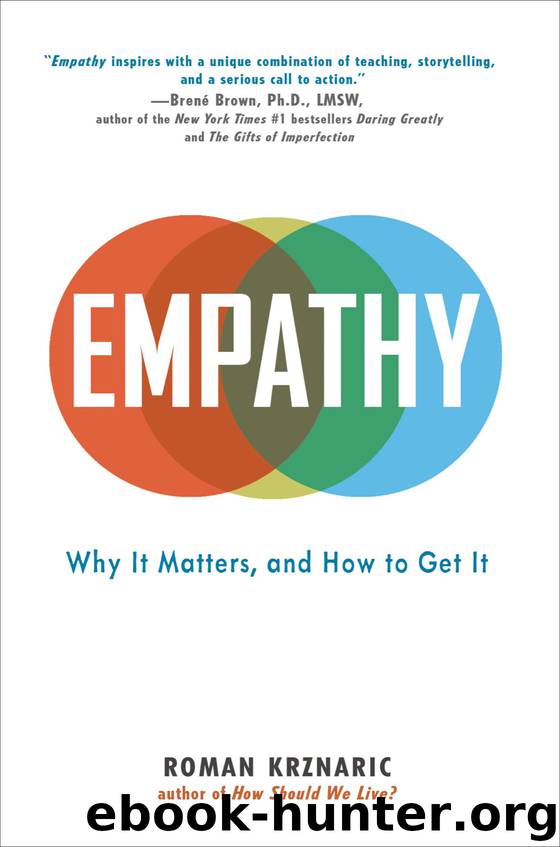Empathy by Roman Krznaric

Author:Roman Krznaric
Language: eng
Format: epub
Publisher: Penguin Group US
Published: 2014-10-20T04:00:00+00:00
CONCERN FOR THE OTHER
It is quite possible to show a willingness to remove your mask, or to be an excellent listener, but still take a self-centered and utilitarian approach to conversation by putting your personal interests before anybody else’s. You might view communication as a way of getting what you want, meeting your own emotional needs, or controlling and manipulating people. That is why highly empathic people bring an attitude of concern for the other into their conversations, and strive to focus on the other person’s interests and well-being, not just their own.
The importance of this trait becomes clear in the debate over so-called empathy marketing. During the past decade, empathy has become a popular concept in the advertising and marketing industries, where it tends to be seen in purely instrumental terms. In his best-seller Persuasion: The Art of Influencing People, James Borg describes empathizing—especially the art of accurately reading people’s emotions in face-to-face conversation—as a key sales skill to give you “a competitive edge that can really set you apart and help you get what you want.” “When you look at the behaviors and mindsets of the most successful people around,” writes Borg, “it’s apparent that they have a great understanding of the role of empathy.”40 Numerous marketing websites offer tips on how to use empathic communication strategies to lure in customers, such as asking people about their families to help make a personal connection, ensuring that you look people in the eye when talking to them, and becoming observant of their body language and tone of voice as a way of tuning into their state of mind. One marketing consultant observes, “Obvious though empathic communication techniques may be, my clients routinely neglect to use them . . . and leave billions of dollars on the table as a result.”41 There are now firms specializing in empathy marketing, training telesales workers to make people feel as if they are really being listened to.42
An insightful commentator on this growing role for empathy in business is the political scientist Gary Olson. He argues that empathy marketing—or what he also calls “neuromarketing”—is often described in benevolent terms as a way for businesses to respond to consumers’ needs and desires, by trying to develop a sophisticated understanding of how they think and feel. But in reality, says Olson, it is little more than a clever strategy to boost sales and profits: “In short, putting oneself in another’s shoes is a technique for selling them another pair.”43 Under this interpretation, empathy is having its moral content sucked out of it because the marketing industry displays little genuine concern for consumers’ welfare.
Is empathy marketing as pernicious as Olson claims? Are businesses using empathic communications techniques to exploit their customers rather than to be sensitive to their interests? Looking back over the rise of mass consumerism, he may well be right. Although the concept of empathy is a new one in business circles, it has been used by marketing experts—in all but name—for nearly a century.
Download
This site does not store any files on its server. We only index and link to content provided by other sites. Please contact the content providers to delete copyright contents if any and email us, we'll remove relevant links or contents immediately.
Should I Stay or Should I Go? by Ramani Durvasula(7562)
Why We Sleep: Unlocking the Power of Sleep and Dreams by Matthew Walker(6618)
Fear by Osho(4659)
Flow by Mihaly Csikszentmihalyi(4634)
Rising Strong by Brene Brown(4377)
Why We Sleep by Matthew Walker(4359)
The Hacking of the American Mind by Robert H. Lustig(4318)
How to Change Your Mind by Michael Pollan(4290)
Too Much and Not the Mood by Durga Chew-Bose(4270)
Lost Connections by Johann Hari(4096)
He's Just Not That Into You by Greg Behrendt & Liz Tuccillo(3830)
Evolve Your Brain by Joe Dispenza(3610)
The Courage to Be Disliked by Ichiro Kishimi & Fumitake Koga(3413)
Crazy Is My Superpower by A.J. Mendez Brooks(3329)
In Cold Blood by Truman Capote(3306)
Resisting Happiness by Matthew Kelly(3301)
What If This Were Enough? by Heather Havrilesky(3270)
The Book of Human Emotions by Tiffany Watt Smith(3237)
Descartes' Error by Antonio Damasio(3229)
